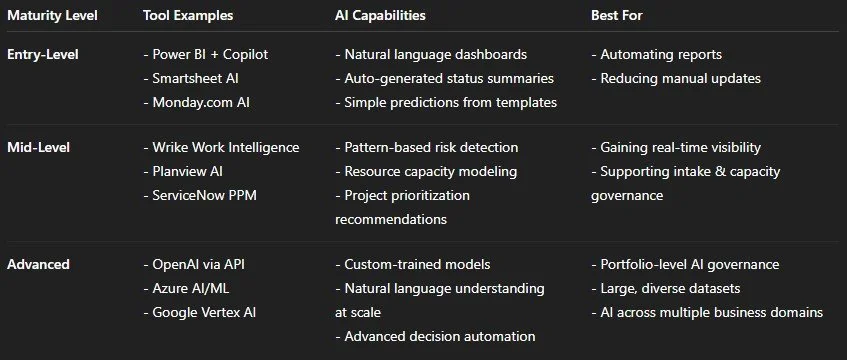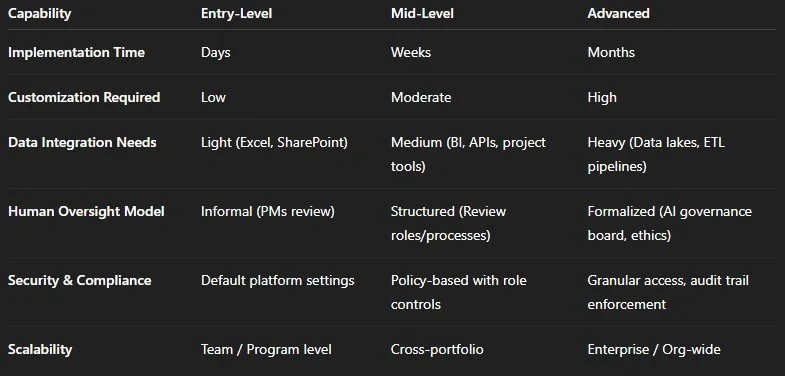The AI-Powered PMO, Part 3: How to Implement AI to Strengthen Governance and Delivery
From Vision to Execution
AI has captured the imagination of project leaders, CIOs, and portfolio managers alike. The benefits are clear—faster decision-making, smarter resource allocation, and earlier risk detection. But for most PMOs, the real challenge isn’t why or what—it’s how to get started.
This article is your bridge between strategy and execution.
You don’t need to be an AI engineer. You need a plan.
What Changes As You Move Up?
“The future isn’t about automating project management. It’s about augmenting it—intelligently, transparently, and responsibly.”
1. Start with a Pilot, Not a Platform
Don’t aim to “AI-ify” your entire PMO overnight. Start small and targeted:
Choose a process with repeatable tasks or high manual effort.
Focus on one domain:
Risk flagging
Project intake prioritization
Resource forecasting
Portfolio health reporting
Use existing tools first—no major tech investment required
Example: Use Power BI + Copilot to automate weekly project status summaries from existing tracker data.
Pro Tip: Define measurable success criteria before rollout—time saved, accuracy improved, manual steps reduced.
2. Choose Tools That Match Your Maturity
You don’t need enterprise-grade AI to get started—but you do need to know what you’re getting. PMOs at different stages require different levels of functionality, integration, and oversight.
Here’s a breakdown of tool categories aligned with PMO maturity and what they typically offer:
Key Takeaway:
Start with what your team can manage—not just what sounds impressive.
AI is not all-or-nothing. If your team is drowning in manual reporting, entry-level AI can free them. If you’re facing tough prioritization trade-offs, mid-tier tools can help weigh outcomes. And if you’re running a high-stakes, high-volume portfolio—advanced AI can support complex, traceable governance at scale.
3. Define Roles That Make AI Safe and Scalable
AI can analyze, suggest, and even summarize—but only people can provide accountability.
Key roles to support responsible rollout:
PMO Leader – Owns the governance model and communication strategy
AI-Augmented PM – Trained in tool use, feedback provider, not blind executor
Governance Reviewer – Audits AI-influenced decisions for bias or exceptions
Change Manager – Ensures the rollout is supported and adopted
Build human-in-the-loop checkpoints into every use case.
4. Embed AI into Your Delivery Framework
You don’t need to redesign everything—just extend it.
Where to embed AI in existing PMO workflows:
Project intake: Use AI to score initiatives for strategic alignment
Status reporting: Generate first-draft reports or executive summaries
Risk reviews: AI flags pattern-based risks across similar past projects
Portfolio meetings: Include AI-generated insights, always human-reviewed
Add governance roles for AI validation and override approvals.
5. Prepare Your Data and Processes
AI is only as good as the data it’s given. Most PMO pain points come not from the model, but the messiness of project data.
Foundational steps:
Clean and normalize your project metadata (status types, milestones, tags)
Use consistent time tracking and resource logging
Store data in a central repository accessible to your AI tool (e.g., Dataverse, SharePoint, SQL)
6. Avoid These Common Pitfalls
🔒 Black box behavior – Always make model logic or outputs explainable
🧠 Over-trust – AI is a tool, not a decision-maker. Guard against automation bias.
😓 PM fatigue – If AI feels like just another process layer, adoption will fail
❌ No success criteria – If you don’t define “done right,” you won’t know when you’ve succeeded
PMOs Are the Best Place to Pilot Responsible AI
Your PMO already handles structure, reporting, governance, and value. It’s the ideal place to launch AI initiatives because it’s process-aware, people-centric, and outcome-driven.
When implemented with intention, AI becomes the ultimate project assistant—offloading tasks, highlighting risks, and supporting governance, not replacing it.
If you’re a small business looking to integrate AI-Accelerators into your pmo, let’s talk. I have some recommendations on tools you can implement that won’t break your budget and will deliver immediate value to your PMO and your organization.
About the Author
Richard Joseph is Managing Director of Tech Lens Advisors, where he helps organizations realize the full value of technology through strategic advisory, digital transformation, and change leadership. With many years of experience across many application and cloud platforms, and enterprise delivery, he brings a practical lens to innovation—especially when it comes to the role of AI in project and portfolio management.
He believes AI works best when paired with strong leadership, transparent governance, and a clear understanding of people and process.
You can follow Richard’s insights and articles at TechLensAdvisors.com and connect with him on LinkedIn to continue the conversation.


